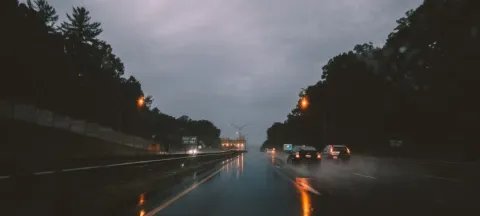Wider pavement markings could make highways safer

Making pavement markings two to four inches wider can significantly reduce collisions on Canadian highways, new research from the University of British Columbia, the University of Alberta and McMaster University suggests.
The study, which analyzed eight years’ worth of data from more than three dozen highway segments across Canada, found that after longitudinal road surface markings were increased from four inches to six or eight inches in width, total collisions decreased by 12 per cent.
Run-off-the-road collisions, where a car leaves the road before crashing, decreased by 19 per cent following the change.
“Highway drivers rely almost entirely on pavement markings to position themselves on the road, especially in poor weather conditions,” says study author Tarek Sayed, a traffic safety expert and professor of civil engineering at UBC. “So the question of whether wider markings can improve road safety is an important one to address.”
Previous research indicated that increasing the width of pavement markings can enhance visibility and driver comfort. But the few studies that analyzed real-world collision data have not been conclusive, and most Canadian road authorities have continued to use the narrowest recommended width — four inches — in order to minimize costs, says Sayed.
To help fill this knowledge gap, the researchers examined traffic and collision data for 38 rural highway segments in British Columbia, Alberta and Quebec between January 2008 and December 2015. Their analysis revealed a reduction in collision frequency after edge lines, median lines and centrelines at the sites were widened between 2012 and 2013.
Total collisions went down by 11 per cent in B.C. and by 27.5 per cent in Alberta after the intervention. (Quebec saw a reduction of only one per cent, possibly due to the low number of treated sites in the province.) Run-off-the-road collisions dropped by 29 per cent in Alberta, by 23 per cent in British Columbia and by 25 per cent in Quebec.
“More Canadian road authorities should consider widening their pavement markings, particularly in areas where run-off-the-road collisions are common,” says Sayed. “It’s a simple, cost-effective measure that a growing body of evidence suggests could very well prevent accidents and deaths.”
To help ensure that the observed reductions were not due to other factors, the researchers compared the data from the 38 treated sites to data from 170 comparison sites — nearby highway segments that were designed and operated similarly to the treated sites, and that had not undergone any major construction during the same eight-year study period.
Future work could explore how widening pavement markings affects road safety in cities and other non-rural areas, say the study authors. It could also investigate the impact of wider pavement markings on other specific types of accidents, like head-on collisions, or how collision frequency changes with different marking widths.
The study appears in the July issue of Accident Analysis and Prevention.


